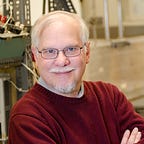Knowing what to see
The idea that the mind processes information about the external world and imposes order on it goes back at least as far back as Immanuel Kant: Thus the order and regularity in appearances, which we call Nature, are put there by ourselves. We could never find them in appearances if it weren’t that we, or the nature of our mind, had first put them there. In their classic 1972 paper on punctuated equilibrium, Eldredge and Gould discussed the “cloven footprint of theory;” that the mind set imposed by theory biases our perception of data. They argued that the expectation of gradual change prevented the recognition that stasis characterizes the history of most species.
As I write this, our introductory Earth science students are about to depart for their first true field trip, a week-long excursion into the Missouri Ozarks. They will spend entire days outdoors, learning what rocks look like in the field, rather than in a textbook or the laboratory. My favorite part of the trip is the “silent stop.” Students walk individually along an inactive rail line and cannot talk to each other; they raise their hands when they figure out what is there. For some, recognition is almost immediate; for others it takes two or three walks back and forth. Eventually, all have the “aha!” moment when they realize that there are a set of faults. But it is not until they see the first one that they make the mental shift to see all the ones that are there. Then they are obvious. Such times, when the mind sees a previously unrecognized pattern, is one of the most exciting moments in science.
This type of mental shift has happened more than once in my own work. A number of years ago a group of students and I visited an Ordovician limestone quarry. At one corner of the quarry was a huge body of sandstone, siltstone, and clay with abundant plants. Elsewhere in the area, these much younger Pennsylvanian age sediments were directly above the Ordovician limestones, separated by a deep erosional surface. Here, however, the Pennsylvanian age material was embedded within the Ordovician. We were deeply confused until then graduate student Todd Ventura said “it’s a cave!” All of a sudden what we saw made sense; the Ordovician rocks had been eroded to produce caves which then filled in. The new mental model imposed order on what we observed.
More recently, colleagues encouraged me to look at a fossil named Essexella. This is the most common animal in Mazon Creek, a world-famous fossil site in Illinois known for preserving soft-bodied organisms. Almost 40 years ago, Essexella was described as a jellyfish. My colleagues and I agreed that this made little sense; what we saw did not fit any jellyfish group we knew of. Then I had my “aha” moment — what if we turned it upside-down and interpreted it as an anemone? Amazingly, everything that was confusing when we saw it as a jellyfish now made sense when we looked at it as an anemone.
Sometimes entire fields make such mental readjustments, what Thomas Kuhn famously described as a paradigm shift. Until the late 1960’s all of geology was interpreted based on the ideas that continents were fixed in place. Many of the lines of evidence that we cite to support plate tectonics, such as the matching of continental outlines, the depth of earthquakes, and the distribution of terrestrial animals, were known long before the theory was proposed. The critical step was placing all of this evidence and some key new data into the novel framework. That the old data fit the new theory was now obvious. What changed was how the data was placed into a new world view. According to Richard Kerr in a 1983 article in Science, old geologists say, “I wouldn’t have seen it if I hadn’t believed it.” (this aphorism is actually attributed to Marshall McLuhan). Accepting plate tectonics made “old geologists,” including many of my undergraduate professors, see new things.
Of course there is true order in nature, whether or not we recognize it. But our ideas about what we should see color what we recognize. When those ideas change, what we recognize changes, and our knowledge advances. Seeing the world in a new way that improves understanding is incredibly rewarding. And it is so much fun!
